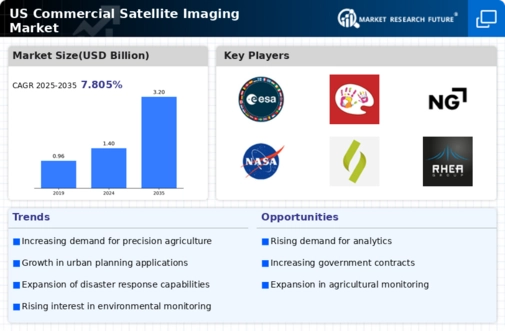Emergence of New Market Players
The commercial satellite-imaging market is experiencing a notable influx of new entrants, which is reshaping the competitive landscape. Startups and established companies are increasingly investing in satellite technology, leading to innovative solutions and services. This diversification is likely to enhance market dynamics, with projections indicating a growth rate of around 9% as competition intensifies. New players often focus on niche applications, such as disaster management and precision agriculture, which could expand the overall market reach. The entry of these companies fosters innovation and drives down costs, making satellite imagery more accessible to various sectors. This trend suggests a vibrant future for the commercial satellite-imaging market.
Increased Demand for Geospatial Data
The commercial satellite-imaging market experiences heightened demand for geospatial data across various sectors, including agriculture, urban planning, and environmental monitoring. As industries increasingly rely on accurate and timely data for decision-making, the market is projected to grow significantly. For instance, the agricultural sector utilizes satellite imagery to optimize crop yields and monitor land use, which could lead to a market expansion of approximately 15% annually. Furthermore, urban planners leverage this data to enhance infrastructure development, indicating a robust growth trajectory for the commercial satellite-imaging market. The integration of advanced analytics with satellite data further amplifies its utility, suggesting that the market will continue to evolve in response to these demands.
Growing Interest in Climate Change Monitoring
The commercial satellite-imaging market is increasingly recognized for its role in climate change monitoring and environmental management. Governments and organizations are investing in satellite technology to track changes in land use, deforestation, and greenhouse gas emissions. This focus on sustainability is likely to drive market growth, with estimates suggesting a potential increase of 10% in market size over the next few years. The ability to provide real-time data on environmental conditions enhances the effectiveness of climate policies and initiatives. As awareness of climate issues rises, the demand for satellite imagery to support research and policy-making is expected to expand, further solidifying the commercial satellite-imaging market's importance.
Technological Advancements in Imaging Systems
Technological innovations in imaging systems are driving the commercial satellite-imaging market forward. Enhanced sensor technologies, such as multispectral and hyperspectral imaging, provide more detailed and accurate data, which is crucial for various applications. The introduction of high-resolution imaging capabilities allows for better monitoring of environmental changes and urban development. As of 2025, the market is expected to witness a growth rate of around 12%, fueled by these advancements. Additionally, the development of smaller, more efficient satellites reduces operational costs, making satellite imagery more accessible to a broader range of industries. This trend indicates a promising future for the commercial satellite-imaging market as technology continues to evolve.
Expansion of Defense and Security Applications
The commercial satellite-imaging market is witnessing a surge in demand from defense and security sectors. Governments are increasingly utilizing satellite imagery for surveillance, reconnaissance, and intelligence gathering. This trend is likely to contribute to a market growth rate of approximately 8% annually. The ability to obtain high-resolution images of strategic locations enhances national security efforts and aids in disaster response planning. Moreover, the integration of satellite data with other intelligence sources improves situational awareness for defense agencies. As geopolitical tensions persist, the reliance on satellite imagery for security applications is expected to bolster the commercial satellite-imaging market significantly.

























Leave a Comment